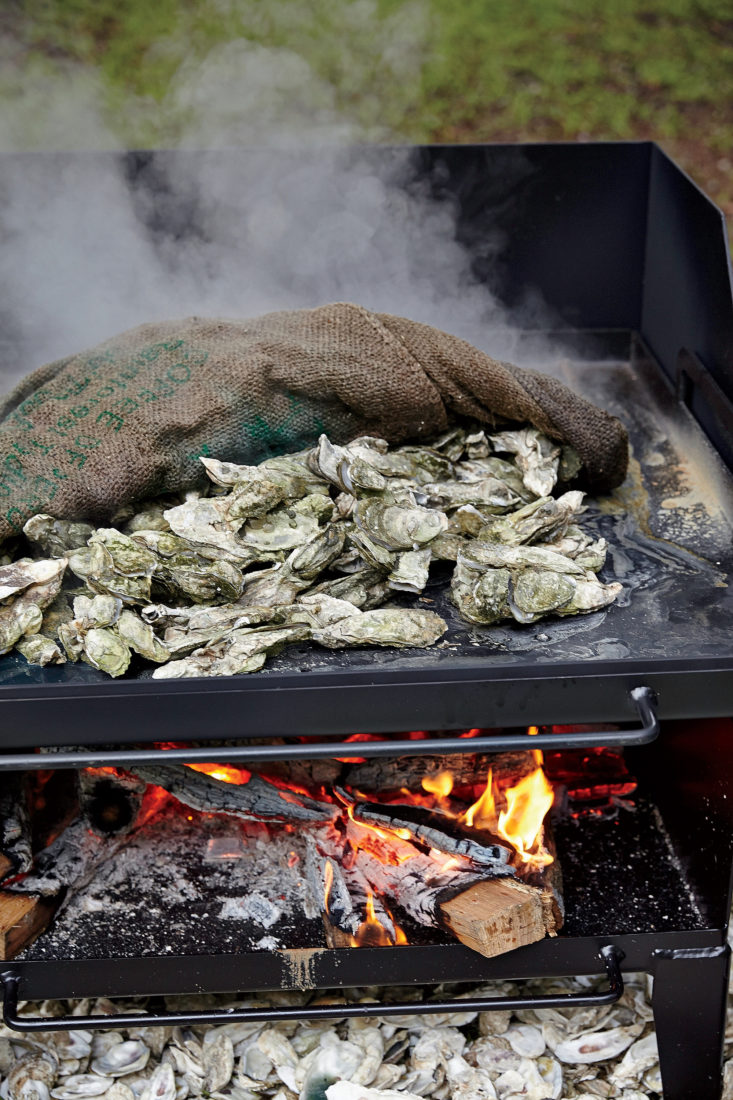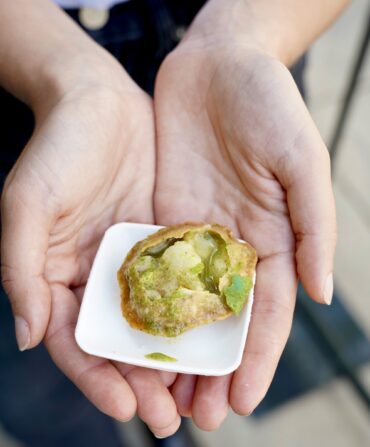This year, wintertime oyster roasts will feature smaller gatherings of close family, rather than the typical bunches of friends and bottomless bushels. But that doesn’t mean you want to slack on the details. We asked some of the South’s oyster roast aficionados to share their secrets for everything from transporting the bivalves to building a fire to discarding the shells. Follow their rules for a guaranteed shucking good time.
Choose the right oyster for your crowd.
Given that we’re still in pandemic times and your oyster roast crowd will be limited to a few close family members, most experts recommend going with singles. “If you are only serving oysters, I recommend ten to twelve oysters per person,” says Kevin Dubel, the executive chef at Tin Cup Kitchen + Oyster Bar in Virginia Beach, Virginia. “If you are serving additional food, go with four to six per person.” Of course, clusters are a coastal institution, more affordable, and steam really well. If you’re Team Clusters, Adam Evans, the executive chef at Automatic Seafood & Oysters in Birmingham, Alabama, recommends getting one bushel for every six people since clusters are generally much smaller than singles.
If you aren’t on the coast with easy access to fresh oysters, talk to local seafood restaurants to see if you can buy directly from them, suggests Bryan Rackley, the co-owner and oyster bar director at Kimball House and Watchman’s in Atlanta, Georgia. If not, ask if they can recommend a place to order from. For farmed oysters that ship, Rackley likes N. Sea Oysters out of Topsail, North Carolina. Look for his favorite variety, Divine Pines.
Give them the sniff test, then clean those suckers.
When it comes to clusters, “dirty oysters mean they are fresh,” Evans says. “Spray the mud off with a high-pressure water hose.” If space allows, store them in the fridge. But if you can’t—or if you are transporting them—put the oysters in a cooler with ice on the bottom rather than dumped over top. “Fresh water will cause the oyster to open up and die,” he says. So be sure to allow melted ice to drain if you’re storing them for a longer period of time. And relax, you aren’t likely to give your family food poisoning. “Vibrio vulnificus and Vibrio parahaemolyticus will die when cooked thoroughly,” says Rackley of the bacteria often associated with seafood. “So as long as you and your guests aren’t eating the oysters raw after they’ve been sitting out in warm weather for a long time, you should be golden.” And, if the oysters have gone bad, your nose will know. “It will smell like you’ve been punched in the face,” Evans says.
Get that fire started ASAP.
Whether you’re cooking over a pit, cauldron, or grill, one of the biggest mistakes you can make is not getting your fire started early enough. “Whatever cooking device you’re using should have a hot bed of coals, from wood if possible, in it when your guests arrive,” Rackley says. “If there are variables like weather or under-cured wood that make your fire difficult to start, you’ll want to troubleshoot those in advance, so your friends aren’t sitting around watching you try to light a fire.” He recommends getting a small propane torch from your local Ace Hardware, and staying away from those gas station bundles of wood, which often contain moisture. “I can’t overstate how much simpler your life is when your wood has been appropriately dried,” Rackley advises. “In my oven, I stack small pieces of wood like Lincoln Logs with a paper bag in the center. Hit it with the torch for fifteen to twenty seconds and you should be good. Add more wood once your fire is ripping and your logs are starting to break down.” You’ll know the roasting surface is good to go when you flick water on it and the surface sizzles.
Cook quickly and in batches.
“Don’t overcook them,” warns Hunter Evans, the executive chef at Elvie’s in Jackson, Mississippi. Just cover them in damp burlap and then “roast them till they barely open. If you don’t need your oyster knife to open them then they are overcooked. What’s the point of an oyster knife if you don’t need it to open an oyster?” Adam Evans agrees: “They will not need as long as you think. If you spread in a flat layer and have a good amount of steam and nice heat it could take as little as five to seven minutes,” he says, adding that cooking in batches will yield more even results and ensure that your guests have a constant rotation of hot oysters. Use a shovel to dump the oysters, steaming hot, onto the table for your guests.
Have a spread of condiments.
Obviously, you’ll want to provide the expected oyster accoutrements: cocktail sauce, horseradish, lemons, oyster crackers, a selection of hot sauces…and beer. Rackley also loves to grill sourdough bread for his guests. “It’s great to have on hand because it’s filling and tastes great when it’s cooked over wood and dipped in butter.”
Don’t pass on the pea crab!
“Hell yeah, you should eat the pea crab, they are the popcorn of the sea,” Rackley says of the tiny orange crustaceans that sometimes make their homes inside oysters (you can read all about them here). And going into the New Year, there’s another reason to give one a crunch, Dubel says: “Not only is it delicious, but it’s also good luck!”
Discard shells properly.
Ask local seafood restaurants—or whoever you bought your oysters from—if there’s a shell recycling center nearby. “If you are by the water, there are generally some nonprofit organizations that help with waterway conservation that will be happy to take them off your hands,” Dubel suggests. You can also check with local farmers to see if they need them for their compost piles, or consider working them into your landscape design, says Hunter Evans: “I have thrown oyster shells in my backyard to replace rocks for landscaping. Just clean them before you use them or else you will have one smelly dog—they love rolling in the shells.”








